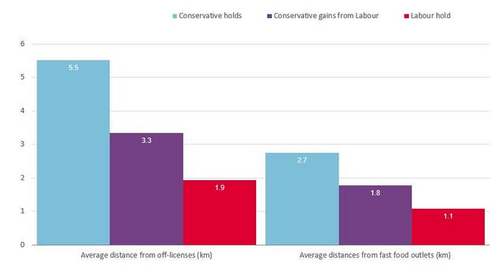Adam Tinson, senior analyst at the Health Foundation, told The Independent: “There are worrying signs that the prime minister has still not grasped the full extent of the challenge facing the country and its seriousness.
The policies that have been trailed ahead of the expected strategy on obesity, suggest that the government may continue its approach of pursuing isolated policies that, on their own, will have little impact on levels of obesity.”
According to an analysis based on election results by ward, Public Health England’s National Child Measurement Programme and density of fast food outlets in local areas, the Health Foundation says red wall areas could stand to lose out the most if the obesity strategy fails to tackle wider population level issues.
It said people’s exposure to the multiple causes of obesity was not the same across the country. Residents living in red wall seats live close to fast food outlets and off licenses than compared with traditional Conservative-held seats.
Former Labour-supporting areas in the north of England which voted Conservative in the last general election are at a greater risk from the root causes of obesity a new analysis has shown.

The work by the Health Foundation comes as ministers are expected to unveil the government’s obesity strategy this week and suggests the “red wall” areas have higher rates of childhood obesity, more fast food outlets and generally suffer worse deprivation.
The Health Foundation has warned the government must not continue with a failed approach of targeted single interventions and instead focus on wider inequalities and factors that lead people into living unhealthy lives, what are known as the social determinants of health inequalities.
Prime minister Boris Johnson has reportedly been trying to lose weight and get healthier following his coronavirus infection that left him fighting for his life. Politically, Mr Johnson has been opposed to state interventions in people’s personal lives and it had been hoped his new attitude would change the government’s policies on so-called “sin-taxes”.
Analysis shows the former red wall areas are exposed to higher obesity risks than traditional Tory areas

Conservative areas tend to have on average 77 fast food outlets per 100,000 people compared with 114 in red wall areas that voted Tory in the last election.
Those seats also have higher rates of childhood obesity, seeing larger increases over the last decade compared to Tory seats. Rates of obesity for year six children, aged 10-11, increased 2.1 per cent on average compared to 0.5 per cent in Tory areas.
In 2018-19, one in five children aged 10-11 were classed as obese.
Mr Tinson added: “‘A credible obesity strategy must reflect the evidence that our health is strongly influenced by the circumstances in which we live which shape whether we can be active or eat healthily.
“It must also acknowledge poverty and inequality as root causes of obesity and recommend action on these fronts. The health of children in the most deprived areas of the country is at risk and this is especially true for the so-called red wall areas that lent the government their votes in the last election.
“It isn’t too late for the government to listen to the evidence and act decisively. Many of the practical solutions are not new. Policies like providing safe cycling and walking routes, restricting adverts for unhealthy food, banning sales of energy drinks to under-16-year-olds, and – as is currently proposed – limiting supermarket promotions of unhealthy food, enjoy broad public support. Several have been included in the government’s previous childhood obesity plans but not implemented, losing out to competing commercial interests.”
Health secretary Matt Hancock has made prevention of ill-health a core part of his strategy at the Department of Health and Social Care.
A prevention green paper published in July last year did include a childhood obesity strategy and policies to end the sale of energy drinks to children and changes to food labelling.
A Soft Drinks Industry Levy was launched in April 2018 which led to companies reducing the average sugar content of drinks subject to the levy by almost 30 per cent between 2015 and 2018.



